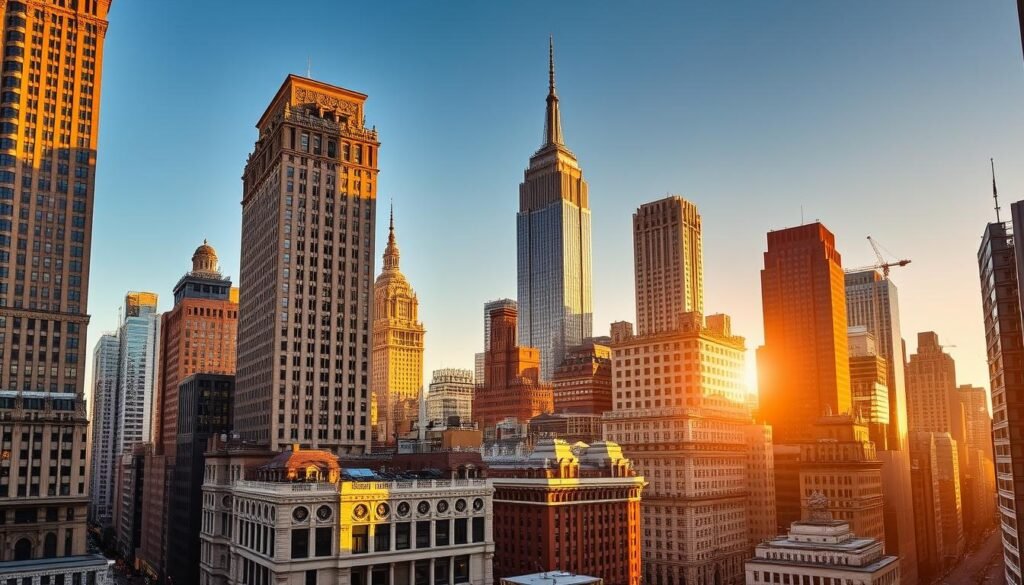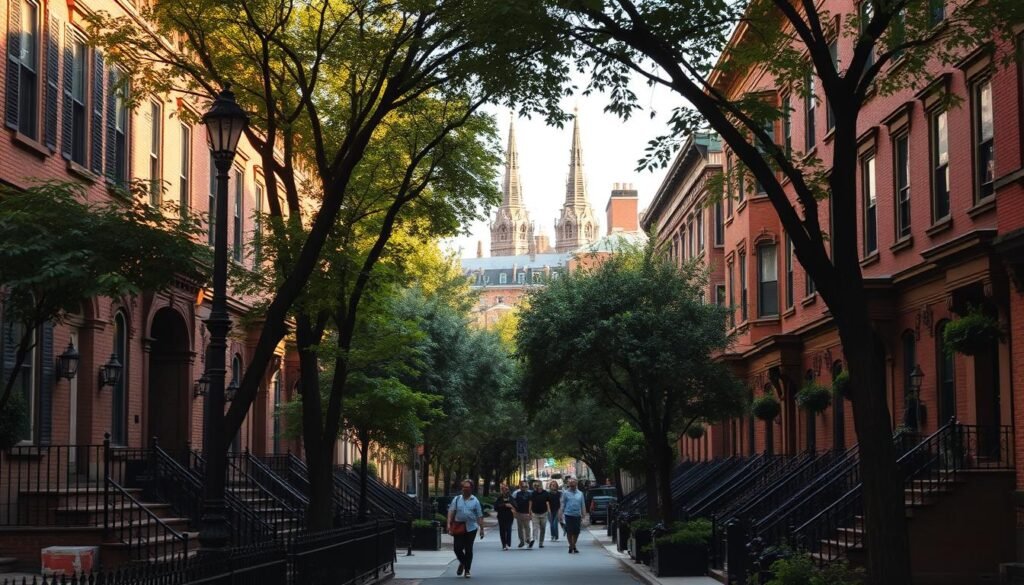Did you know New York City has over 130 historic landmarks? Each one has its own story. From the famous Statue of Liberty to the grand Brooklyn Bridge, the city’s history is seen in its buildings and culture.
The city’s iconic landmarks are more than just sights to see. They are symbols of New York’s identity and past. They show the city’s rich cultural mix and important events that made it a global city.
Key Takeaways
- New York City boasts over 130 historic landmarks.
- Iconic sites like the Statue of Liberty and Brooklyn Bridge are must-visit destinations.
- The city’s landmarks reflect its diverse cultural heritage.
- These landmarks are integral to New York’s identity and history.
- They attract millions of tourists and history enthusiasts every year.
The Rich Historical Tapestry of New York City
New York City’s history is rich and varied. It started as a small Dutch colony and grew into a global city. The city’s many historical sites show its complex past.
From Dutch Colony to Global Metropolis
New York City’s story began with the Dutch Colony in the early 17th century. Its location made it key for trade and commerce. This set the stage for its growth.
Important sites from this time include:
- The original wall of New Amsterdam, which later became Wall Street
- Trinity Church, one of the oldest churches in the city
- The St. Paul’s Chapel, a historic Episcopal chapel
These sites show how the city grew from a small Dutch settlement to a bustling metropolis.
Why New York’s Historical Sites Matter Today
New York’s historical sites are more than just old buildings. They remind us of the city’s rich culture and history. Places like Washington’s Headquarters in Newburgh and the Women’s Rights National Historical Park in Seneca Falls offer insights into key moments in American history.
These sites are important today because they:
- Keep alive the stories of important events and people
- Teach visitors about the city’s past and its influence today
- Add to the city’s cultural identity and heritage
By exploring and saving these sites, we learn more about New York City’s impact on American history.
The Statue of Liberty and Ellis Island: America’s Iconic Gateways
Liberty Island and Ellis Island are more than just monuments. They are the heart of American identity. Located in New York Harbor, they symbolize freedom and opportunity.
Lady Liberty: Symbol of Freedom and Hope
The Statue of Liberty, a gift from France in 1886, is a symbol of freedom. Designed by Frédéric Auguste Bartholdi and built by Gustave Eiffel, it has welcomed millions. It stands as a beacon of hope for a better life.
Ellis Island Immigration Museum: Stories of Arrival
The Ellis Island Immigration Museum shares the stories of millions of immigrants. It showcases personal stories, artifacts, and immigration history. It highlights the challenges and triumphs of those seeking a better future.
Planning Your Visit to These National Monuments
Visiting the Statue of Liberty and Ellis Island is a must for history buffs. Start by booking tickets on the official website. Take a ferry to both islands and spend at least half a day exploring.
By visiting these iconic sites, you’ll understand America’s rich history and values.
Lower Manhattan: Where New York’s Story Began
In the heart of New York City lies Lower Manhattan. It’s where the city’s story first began. This area has been key to New York’s growth, from a Dutch colony to a global financial center.
Federal Hall and the Birth of American Democracy
Federal Hall is a landmark of huge historical importance. It’s where George Washington became the first President of the United States. This event started American democracy, and Federal Hall symbolizes the country’s democratic values.
Visitors can explore the hall and museum. They learn about the early days of American governance.
Wall Street and Financial History
Wall Street, in the heart of Lower Manhattan, is a financial powerhouse. It’s been at the center of American finance for centuries. The New York Stock Exchange (NYSE), the world’s largest, is here.
Walking down Wall Street, you feel the history of finance all around you.
“The street is a symbol of financial power and has been the hub of American finance for centuries.”
Trinity Church and St. Paul’s Chapel: Colonial Sanctuaries
Trinity Church and St. Paul’s Chapel show Lower Manhattan’s colonial past. Trinity Church, with its Gothic Revival architecture, has stood tall in the New York skyline. St. Paul’s Chapel, built in 1766, is one of the oldest places of worship in New York City.
Both churches reflect the community’s enduring spirit. They were a refuge during the September 11 attacks.
Lower Manhattan is more than a historical district. It’s the foundation of New York City. Landmarks like Federal Hall, Wall Street, Trinity Church, and St. Paul’s Chapel tell the city’s story. From a small Dutch settlement to a global metropolis, New York has grown.
Must-Visit History Places in New York for Architecture Lovers
New York City is full of amazing architectural wonders. From suspension bridges to Art Deco skyscrapers, there’s a lot to see. Architecture fans can dive into the city’s history through its famous landmarks.

Brooklyn Bridge: Revolutionary Engineering Marvel
The Brooklyn Bridge was finished in 1883. It was the first steel suspension bridge in the world. This iconic landmark links Brooklyn and Manhattan, showing off the Manhattan skyline. Its design and engineering are reasons why it’s a top spot for architecture lovers.
Grand Central Terminal: The Heart of the City
Grand Central Terminal is a Beaux-Arts gem and one of the biggest train stations globally. Its grand design, like the magnificent main concourse with an astronomical ceiling, is loved by many. Visitors can see its detailed work and lively vibe.
Empire State Building: Art Deco Masterpiece
The Empire State Building is an Art Deco icon and a symbol of New York City. It was the tallest building in the world for many years. Its distinctive silhouette and elegant style inspire architects and visitors.
These landmarks show New York City’s rich history and culture. Seeing these places helps us understand the city’s growth and its global influence.
Honoring the Past: New York’s Poignant Memorial Sites
New York City has many memorial sites that honor its history. These sites remember important events and show the city’s complex past.
9/11 Memorial and Museum: Remembrance and Resilience
The 9/11 Memorial and Museum honors the victims of the 9/11 attacks. It has two large pools with the names of those who died. It’s a symbol of the city’s strength after that day.
“The 9/11 Memorial & Museum is a sacred place where we honor the lives and legacies of those who were killed.”
African Burial Ground National Monument: Uncovering Hidden History
The African Burial Ground National Monument reveals the city’s hidden history. It remembers the enslaved Africans buried there in the 17th and 18th centuries. It’s a key reminder of the city’s early struggles.
Grant’s Tomb and Civil War Memorials
Grant’s Tomb and other Civil War memorials honor President Ulysses S. Grant and Civil War heroes. They show the city’s role in the Civil War and the importance of these figures.
In conclusion, New York’s memorial sites are key to understanding the city’s history and resilience. Visiting these sites helps us appreciate the city’s complex past and its journey towards healing and remembrance.
Walking Through History: New York’s Historic Neighborhoods
Walking through New York’s historic neighborhoods, you’ll find layers of history. These areas are not just old; they’re alive with culture and identity.
Greenwich Village: Bohemian Heritage and Literary Landmarks
Greenwich Village has always been a place for artists and writers. It’s known for its bohemian vibe, with spots like Washington Square Park and homes of famous authors. The narrow streets and historic brownstones make it charming.

Harlem’s Cultural Renaissance and Civil Rights History
Harlem was key in the African-American cultural renaissance and the Civil Rights Movement. You can see the Apollo Theater, where stars like Ella Fitzgerald began. The Schomburg Center for Research in Black Culture has a huge collection of African-American history.
Brooklyn Heights and DUMBO: From Revolutionary War to Industrial Age
Brooklyn Heights and DUMBO show Brooklyn’s history, from the Revolutionary War to its industrial days. The Brooklyn Heights Promenade offers great views of Manhattan. DUMBO’s cobblestone streets and old buildings remind us of its industrial past.
These neighborhoods give a special look at New York City’s history and culture. They’re essential for anyone wanting to explore the city’s historic heart.
Museums That Bring New York’s History to Life
New York City’s rich history is kept alive in its many museums. These places not only have historical items but also make the city’s story come alive for visitors from everywhere.
The Metropolitan Museum of Art: 5,000 Years of History
The Metropolitan Museum of Art is a top art museum in the world. It has a collection that goes back 5,000 years. You can see everything from ancient Egyptian artifacts to modern American art here.
It’s a place you must see if you love history, art, or culture.
New-York Historical Society: The City’s First Museum
The New-York Historical Society was founded in 1804. It’s the city’s first museum. It focuses on New York and U.S. history through exhibits, research, and programs.
The society has over 8 million objects. It gives a deep look into the city’s past.
“The New-York Historical Society is a treasure trove of American history, providing insights into the events, people, and cultures that have shaped our nation.”
Tenement Museum: Immigrant Stories and Struggles
The Tenement Museum shares the story of immigrant life in New York City. It’s on the Lower East Side, in a historic tenement building. Through tours and exhibits, you can understand the immigrant experience and its impact on the city.
These museums are just a few of the many cultural spots in New York City. By visiting, you can learn more about the city’s complex history and its role in American history.
Hidden Historical Gems Off the Tourist Trail
New York is full of famous landmarks, but it also has many hidden gems. These sites give a unique look into the city’s history and culture.
The Cloisters
The Cloisters is a medieval monastery in Upper Manhattan. It feels like stepping back into medieval Europe. The museum has amazing medieval art and beautiful gardens.
Morris-Jumel Mansion
In Washington Heights, the Morris-Jumel Mansion is a historic house. It was George Washington’s headquarters during the Revolution. It’s a great place to learn about America’s first president.
Green-Wood Cemetery
Green-Wood Cemetery is one of the oldest and largest in the U.S. It’s where many famous New Yorkers are buried. It’s not just a cemetery but also a beautiful park with views of Manhattan.
| Historical Site | Location | Historical Significance |
|---|---|---|
| The Cloisters | Upper Manhattan | Medieval art and architecture |
| Morris-Jumel Mansion | Washington Heights | George Washington’s Revolutionary headquarters |
| Green-Wood Cemetery | Brooklyn | Final resting place of famous New Yorkers |
Conclusion: Embracing New York’s Living History
New York City’s history is a vibrant, ever-changing tapestry that continues to captivate visitors and residents alike. The city’s historical landmarks, museums, and neighborhoods serve as a testament to its rich cultural heritage.
From the iconic Statue of Liberty to the poignant 9/11 Memorial, New York’s historical sites are a living, breathing entity. They tell the story of America’s past, present, and future. By exploring and preserving these sites, we can gain a deeper understanding of the city’s complex history and its significance in shaping American identity.
As we continue to navigate the complexities of the modern world, New York City’s living history remains an essential part of its allure. It offers a unique blend of tradition, innovation, and cultural expression. By embracing this history, we can ensure that future generations can continue to learn from and appreciate the city’s enduring legacy.
FAQ
What are the must-visit historical landmarks in New York City?
You must see the Statue of Liberty, Ellis Island, and Federal Hall. Don’t miss the Brooklyn Bridge, Grand Central Terminal, and the Empire State Building.
What is the significance of the Statue of Liberty and Ellis Island?
The Statue of Liberty stands for freedom and hope. Ellis Island Immigration Museum honors the millions who came to the U.S. seeking a better life.
What can I expect to see at the 9/11 Memorial and Museum?
The 9/11 Memorial and Museum honors the victims of the 9/11 attacks. It has two large reflecting pools with the names of those who were killed. There’s also a museum with artifacts and stories from that day.
What historic neighborhoods can I visit in New York City?
Visit Greenwich Village, Harlem, Brooklyn Heights, and DUMBO. Each neighborhood has its own unique character and history.
What museums in New York City showcase the city’s history?
The Metropolitan Museum of Art, New-York Historical Society, and Tenement Museum are top museums. They showcase the city’s history and cultural heritage.
Are there any hidden historical gems to explore in New York City?
Yes, explore The Cloisters, Morris-Jumel Mansion, and Green-Wood Cemetery. They offer a glimpse into the city’s rich and complex history.
How can I plan my visit to the Statue of Liberty and Ellis Island?
Book tickets in advance on the Statue of Liberty and Ellis Island website. Then, take a ferry to Liberty Island and Ellis Island.
What is the significance of Federal Hall in Lower Manhattan?
Federal Hall is where George Washington took the oath of office. It marks the beginning of American democracy and is a key historical landmark in Lower Manhattan.
Can I visit Grant’s Tomb and other Civil War memorials?
Yes, Grant’s Tomb and other Civil War memorials are open to visitors. They offer a glimpse into the city’s history and cultural heritage.


Leave a Reply